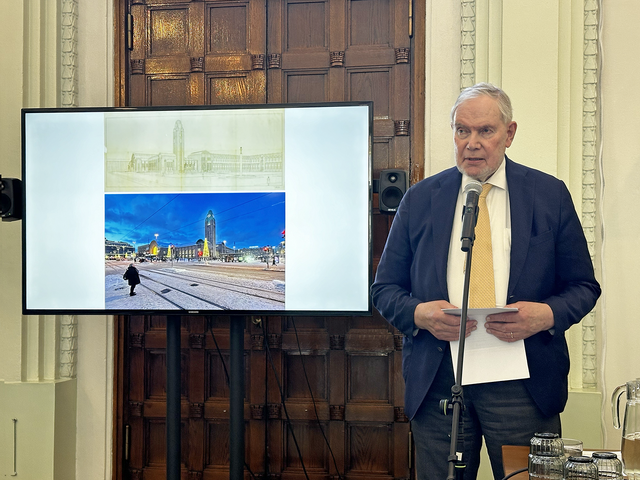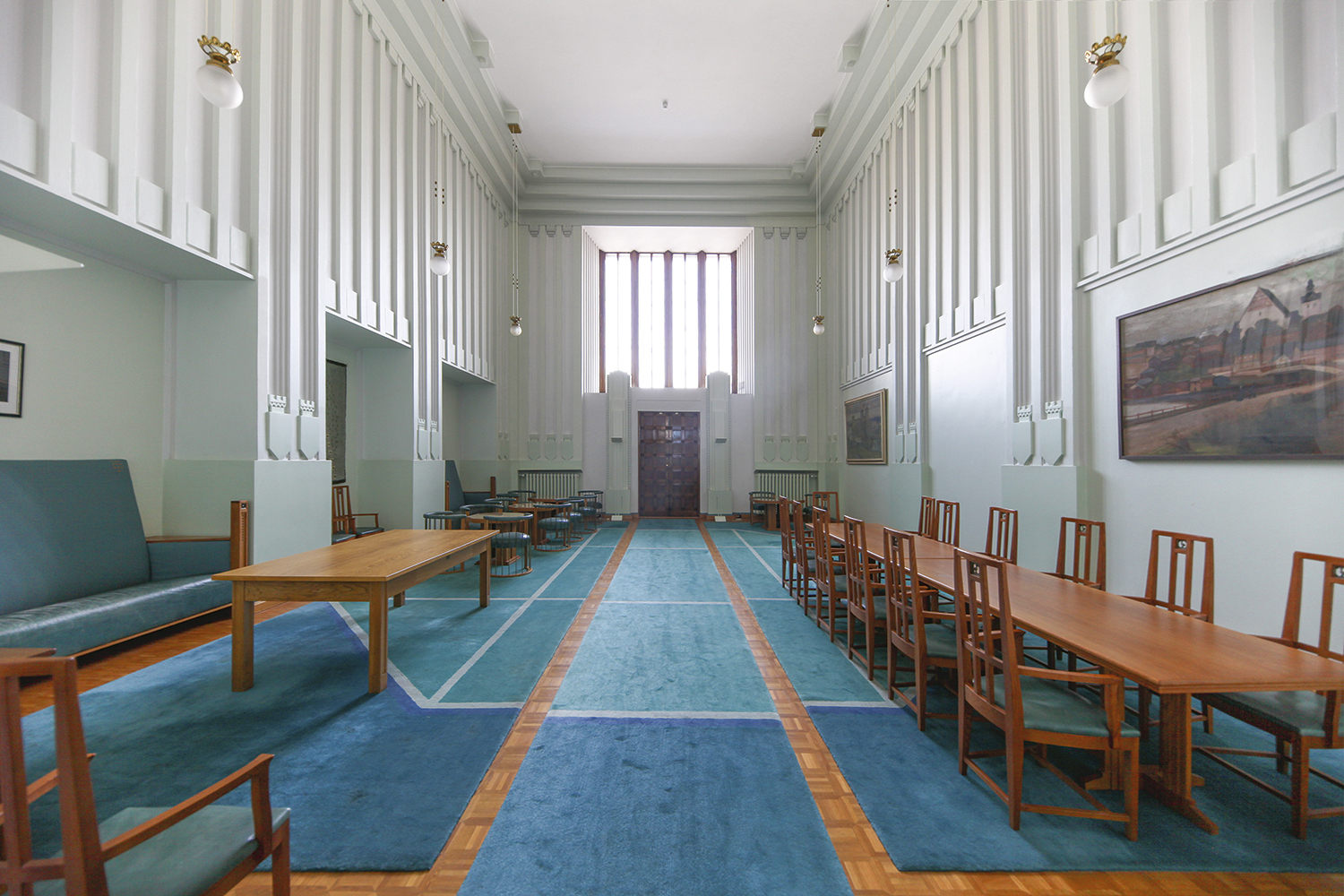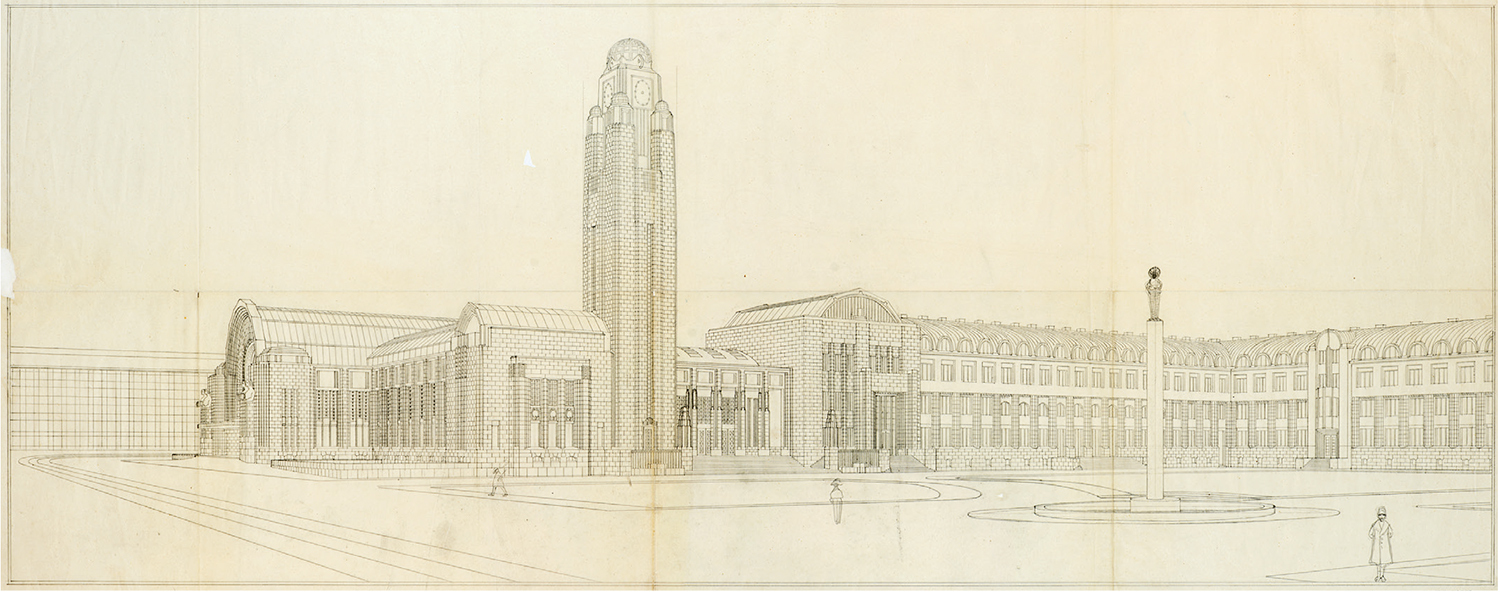Eliel Saarinen, at last!

Miina Jutila
Former Prime Minister Paavo Lipponen is a passionate architecture enthusiast. At Archinfo, we knew of his interest in Eliel Saarinen's architecture and tipped him off to Rakennustieto Publishing for giving a keynote speech at the launch of their new book on Eliel Saarinen. We publish the speech by the self-proclaimed architecture freak in Helsinki Railway Station’s Presidential Lounge on 20 August 2024.
Exactly a year ago, on 20 August 2023, at the request of the Rantasalmi municipal manager, I spoke at Eliel Saarinen’s 150-year jubilee in Rantasalmi Church. On the way there, near the church, I noticed a street sign that read Lipposenpolku – Lipponen Path. The street is not named after me but Pekka Lipponen, a local fictive cartoon hero. Still, I wondered if there was a Saarinen street there as well – after all, Eliel Saarinen was born in the municipality.
The celebration was excellent, with Eliel's grandson and Eero's son, Eric Saarinen, among the speakers. After the impressive ceremony, we went to the town hall and inaugurated a nearby street – Eliel Saarinen Road. This speaks of how the importance of Eliel Saarinen was recognised in Rantasalmi.
I ended up in Rantasalmi after desperately searching for Saarinen’s 150-year festivities here in Helsinki. Where is the main celebration? Nowhere, it appeared. Had Saarinen been Swedish, the King himself would have been invited. Hence, why this modesty? What is wrong with us Finns? Alvar Aalto is not the only great Finnish architect; I dare say this because over the years I have done much of Alvar Aalto-promotion – and, after this event, my next stop will be in Jyväskylä at a symposium organised by Alvar Aalto Academy, an organisation initiated by me.
Today, on Eliel Saarinen's 151st birthday, we can say: At last, Eliel Saarinen!
The book launched today, Eliel Saarinen Public Buildings, really does Eliel justice – it's a great birthday present for him and for all of us. The texts and images open our eyes to the true significance of Saarinen Senior in the history of architecture and design. Congratulations, Jari Jetsonen and Sirkkaliisa Jetsonen, on this remarkable work. The photos in the book are stunning!
At the same time, I have the opportunity to congratulate the architectural firm A- Konsultit on the reconstruction and restoration of the Railway Station and this prestigious Presidential Lounge. Look at this hall! Originally an imperial hall and then a presidential lounge, this hall is like a miniature King's Hall, a very classic space. The architectural heritage, the tradition of antiquity, truly is present here. Here we can hear the echoes of history.

The development of architecture is always linked to history and, in this context, the development of the architecture of Eliel Saarinen's generation in the light of Finland being part of the Russian Empire at the time. But, still, Finland was open, surprisingly so. Compared to Finland’s former capital city, Turku, Helsinki was a remarkably open city – my apologies to the residents of Turku! It was a kind of lucky strike for Finland that Helsinki became the capital, and we were building a nation in an autonomous country.
Eliel Saarinen took inspiration from here and there. He even travelled to America, and Henry Hobson Richardson, for example, was one of the architects who influenced him. This was open-mindedness. Actually, at the time, Finland was the most technologically advanced country in the Nordics. Such was the time, and much more could be said about it.
Now, let’s come to this building, Helsinki Railway Station. I regard this as Saarinen's key work. The first part of the book introduces Saarinen's iconic buildings in different cities in Finland – last year, I visited the renovated and refurbished Lahti City Hall, and the design of its new covered courtyard is ingenious, absolutely brilliant, a must-visit! These are buildings to be proud of in these cities, and we are proud of them all. However, here at the Railway Station, we can already see the transition to the United States.

When we then move on to America – which has a certain continuity in Aalto's career – I see in this building, Helsinki Railway Station, a kind of germ and prototype of the American skyscraper and Art Deco. Minna Chudoba’s thorough doctoral thesis and the Finnish language book based on it have already shed light on Saarinen's American period. However, the book that is now being launched shows Saarinen’s public buildings in America in a breathtaking way. One can but be in awe of the extent of Eliel Saarinen’s work in America!
To begin with Saarinen’s American period, the book presents his ground-breaking proposal for the Chicago Tribune Tower architecture competition, which is truly the paragon of the modern American skyscraper. I once had an architectural guide in New York who claimed that, in the case of at least seven skyscrapers, they were modeled after Eliel Saarinen’s. It was quite an experience.

Saarinen clearly had a signature style, unlike his son Eero. As the book points out, Eliel did not want to identify himself as a modern architect. However, if you think about the emergence of modernism and his relationship to it, he was one. According to Saarinen, his architecture was contemporary. Let's allow him that, but he was indeed a so-called modernist, and contemporary is the most modern of all.
Eliel Saarinen Public Buildings shows Saarinen's open-mindedness, starting with the Chicago skyscraper design and continuing to Kleinhans Music Hall, which is absolutely astounding! Here, he's suddenly using a semi-circular or oval shape; how did he come up with something like that! His style became increasingly simplified, and the last sensation was his and Eero Saarinen's 1940 proposal for the Missonian Art Museum, which was not realised because of the war.

Photos of three different building complexes at Cranbrook Academy reveal a massive monument to architecture and art. It's hard to even begin to comprehend what kind of entity it is. Cranbrook is the epicentre of American Art Deco, and Eliel Saarinen is considered the father of American Art Deco alongside Frank Lloyd Wright. Who in Finland knows about this? The book is indeed an eye-opener because Saarinen’s influence is not really understood here in Finland, for example, at the level of higher administration.
In addition to architecture and design, there’s a third dimension to Saarinen: urban planning. Here, too, he was a pioneer. What is particularly interesting is how he linked buildings and the environment, and also the participation of people in the design process.
Now that Helsinki Railway Station is being restored closer to its original appearance, the question of the building's purpose inevitably arises. Isn't it time to start planning a new purpose for this world heritage site? After all, such a purpose has been found for the Quai d'Orsay in Paris, among other places – it now houses the Musee d'Orsay. This is the place for a significant cultural centre, and most urgently the Elielinaukio Square should be redesigned to make it a piazza, Helsinki's Piazza Navona. Indeed, Saarinen's key work is equal to Rome’s Sant'Agnese Baroque church.
In my opinion, today’s perspective is not quite right on what should be valued. Admitting that the solution is not without problems, Elielinaukio Square should be freed from traffic and only modest service buildings should be erected there. None of those currently planned unsightly, greed-driven monstrosities that would cast shadows over this world heritage site. A little respect – that’s what I’m calling for.
Publishing the book Eliel Saarinen's Public Buildings and the restoration of this space are significant cultural achievements. If only Finns would appreciate what we are the best at!
Read more about the book Eliel Saarinen Public Buildings through this link.
More information on the book at the Rakennustieto webstore.


